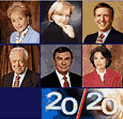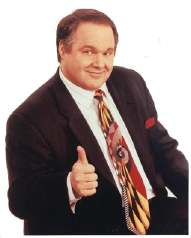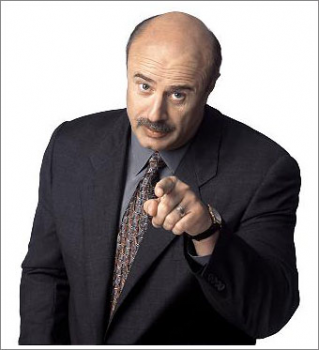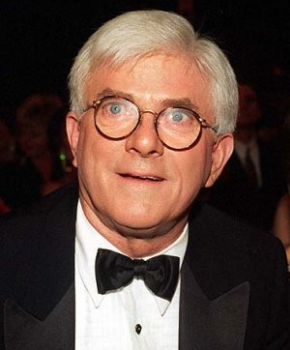Right Turn: Talk TV and Contemporary Politics
by: Rhonda Hammer / UCLA and Douglas Kellner / UCLA

Talk TV – 20/20
Talk television has become increasingly political in the past years. Since Bill Clinton appeared on the Arsenio show and MTV during the 1992 presidential race, presidential candidates regularly appear on TV talk shows. In 2000, both Al Gore and George W. Bush were featured on the Oprah show, acknowledging the importance of daytime talk television, and both Bush and John Kerry appeared on the Dr. Phil show in the 2004 campaign. Moreover, in 1995 the conservative coalition, Empower America, comprised of both Republicans and Democrats like William Bennett and Joe Lieberman, condemned talk shows for promoting “cultural rot.” Since then, there has been a decline of the “trash talk” television of shows like Jerry Springer and an increase of advice shows like Oprah and Dr. Phil.
The content of talk TV has engaged a wide range of political topics over the past decades, addressing controversial issues of gender, race, class, sexuality, war, religion, and other issues of the day, while often taking a partisan caste. Crossfire and The McLaughlin Report in the 1980s initiated highly partisan left vs. right shoutfests, usually pitting hardcore conservatives against softer liberals, to the detriment of the latter.
While Phil Donohue initiated a liberal mode of daytime TV discussion shows focusing on individual and social problems in 1968 and Oprah Winfrey’s show from 1986 to the present has probably been the most successful and influential TV talk show in history, over the past decades, talk TV took a number of bizarre turns to the right. As David Brock recounts in his indispensable 2004 book The Republican Noise Machine, Mort Downey introduced a rightwing populist shout show in the late 1980s, featuring an angry and belligerent host who vented deep resentments against women, people of color, gays and lesbians, and liberals. Shot before a live and handpicked TV audience, raucous fans chanted “Mort! Mort! Mort!” as Downey would attack “pablum-puking” liberals and “liberal slime,” vituperate against gays and women, or shout “Shut up, you old hag!” at an elderly woman (Brock pp. 220f), providing an earlier incarnation of Bill O’Reilly.

Rush Limbaugh
The 1980s and 1990s exhibited the remarkable rise of rightwing talk radio figures, who would eventually make their way into television through extremists like Rush Limbaugh and Sean O’Hannity. As Brock points out, by the late 1990s there were over four hundred major rightwing talk radio shows contrasted to a handful of liberal ones, with one rightwing activist claiming that by 2003, there were 1,700 rightwing talk radio hosts (Brock, p. 273). Furthermore, “today the top five radio station owners in the country, controlling forty-five powerful radio stations, broadcast 310 hours of nationally syndicated rightwing talk every weekday. Only 5 hours of nonconservative talk are aired nationally on those stations” (Brock 2004, p. 300).
The imbalance may be slightly corrected with the rise of Air America Radio, but, nonetheless, the almost total hegemony of talk radio by conservatives is astounding and subversive of genuine democracy. Rightwing talk radio savaged Clinton during his presidency, excoriated Gore during the 2000 election, and rabidly defended the George W. Bush administration while relentlessly disparaging John Kerry during the 2004 election (see Alterman 2003; Brock 2004; and Kellner 2005). It is well-documented that rightwing talk radio shows would coordinate their themes and messages of the day with the Republican party, and that the most influential rightwing hosts often received daily faxes from the Republican leadership (Brock, p. 285).
Rightwing talk radio became the shame of the nation, spewing racist, sexist, homophobic, and hateful anti-liberal discourse, while stigmatizing well-known liberals and relentlessly pushing conservative candidates and issues of the day. In addition to rightwing talk radio, the 1990s exhibited a new form of “trash talk television” in which Jerry Springer would display a wide range of exotic members of the underclass, people of color, and sexual deviants who would often engage in verbal conflict and even fist fights. These shows put on display the nightmare of traditional conservatives, the underclass and people of color out of control and needing discipline, if not incarceration.
By the 2000s, many of the trashier daytime talk shows were cancelled, Oprah continued to reign, and liberal shows like Rosie and, later, Ellen seemed to be ascendant. But during the Bush administration, Dr. Phil has emerged as the most visible and perhaps influential TV daytime talk show. In early January 2005 he featured New Year’s Resolutions week, including the “Dr. Phil Ultimate Weight Loss Challenge.” With his audience decked out in identical sweat-suits exhibiting the weight loss theme of the show, Dr. Phil put on display a number of overweight individuals who looked to him for salvation. Hawking his weight-loss book as shamelessly as Bill O’Reilly uses his show to promote his wares, Dr. Phil engages in endless self-promotion.[1]

Dr. Phil
Indeed, Dr. Phil uses his TV show and web-site to relentlessly sell his books and himself as the solution to America’s problems. Presenting himself as Savior, Dr. Phil tells his audience that he can solve their problems if they just follow his advice. The audience, primarily women, bestows adoring looks of submission on Dr. Phil as the guests extol his wisdom and guidance, promising to do exactly what he advises. As Michelle Cottle points out: “Dr. Phil relies on much the same exploitative freak-show format as Jerry Springer or Jenny Jones, with everyone from drug-addicted housewives to love-starved transsexuals spinning their tales of woe for a salivating audience. But to help himself — and his audience — feel less icky about their voyeurism, Dr. Phil exposes America’s dark side under the guise of inspiring hope and change. In Dr. Phil’s formulation, cheating couples who air every nauseating detail of their sex lives on national television aren’t shameless media whores, they are troubled souls courageous enough to seek help.”[2]The chanting of the day’s slogans and group behavior and Groupthink on the early January 2005 Dr. Phil programs was reminiscent of the 2004 Republican convention and the adoration of George W. Bush. While conservatives once exhibited individualism, independence, and critical thinking as virtues, contemporary conservatives engage in Groupthink, as when followers of talk radio entertainer Rush Limbaugh call themselves “dittoheads” and repeat his lines of the day, however ill-documented and partisan. Exemplifying what Herbert Marcuse (1964) condemned as one-dimensional thought and behavior, Bush conservatives reproduce the slogans of their master and deify a president who has rarely had a thought of his own and reads and performs the scripts of his handlers (see Douglas Kellner’s “Wired Bush” Flow column).
Hence, in addition to the right turn in talk radio and political talk shows documented by David Brock in The Republican Noise Machine, there has been a right turn in daytime talk television. Talk TV is parasitic on social problems and misery caused in large part by social inequalities and the damage of poverty and lack of education. Yet the major programs dedicated to advice and everyday life target individual failings and offer largely individual solutions to a wide range of problems, solutions that reproduce dominant ideology and forms of thought and behavior. Moreover, on daytime talk television, the majority of the guests are women and girls or feminized men, while the host and experts, regardless of gender, embody and uphold traditional patriarchal and dominant middle class codes. The class bias makes working class people feel inferior and sets up middle class and professional people as the social norm and ideal. Importantly, the politics of difference, especially in relation to class, race, gender and sexuality are effectively obscured and depicted as one-dimensional, psychological, personal problems, which tend to blame the victim rather than critique the socio-political and economic contexts which mediate these kinds of pathologies.
In addition, the constellations of aberrant social types and behaviors that are the topic of many of the shows reify the demonization of marginalized groups. In particular, single-mothers (predominantly the working poor and lower classes) and youth (especially, teen-age girls) are favorite targets of daytime talk television. Discussions of genres, which Quail, Razzano and Skalli (2005) identify as teens-out-of-control [TOOC], and the escalating numbers of paternity themed shows, also tend to reinforce dominant, conservative traditional family values that maintain stereotypical gendered relations.[3] Hence, absurd and impossible imaginary standards of idealized images of fathers and mothers — and rigid, bifurcated notions of masculinity and femininity — are further reified. Racist and heterosexist assumptions are often inferentially if not overtly reproduced in depictions of heterosexual families as “normal” and gay sexuality as deviant, while extremely negative depictions of people of color and underclass people multiply.
Class, race, gender, and hetrosexualist bias, however, is often subtly communicated in these shows, masked by an ideology of democratic populism that displays a multicultural rainbow of diversity, often with hosts of color like Oprah or Montel. These hosts tend to reinforce the American myth that anyone can pull themselves up by their “bootstraps” and can overcome racial (class, gender or sexual) inequalities through individual attitude, perseverance and moral character (Jhally and Lewis, 1992).
Moreover, individual authority figures often in the guise of celebrity hosts or guests, as well as slews of so-called professional experts, legitimate the ideologies of individualism and the naturalization of elite hegemonic power, which negates inquiries into social and public responsibilities for transforming social conditions to alleviate oppression and suffering. In this sense, talk TV, as a form of infotainment (i.e. information blended with entertainment) serves as an expansive advertisement for not only its sponsors, but also for the commercial products which it incessantly hypes, as well as the books and services of the hosts and so-called experts, and the commoditization of the viewers themselves who are delivered to sponsors through their TV-watching activity.
Hence, talk television as media spectacle is itself a valuable commodity for the multinational corporations which own and produce them and the laissez-faire and individualistic capitalist values the shows espouse. Media spectacles mesmerize audiences with the sensationalistic news of the day (the O.J Simpson trial, the Clinton sex scandals, the celebrity trials of the moment, and the spectacles of sports and entertainment which dominate everyday life in consumer and corporate capitalism (Kellner 2003)). The real material conditions of the relationships between poverty, rising unemployment, out-sourcing of jobs, the decimation of social assistance and education programs, and the social conditions of escalating violence have no place in the narcissistic celebrity obsessed domain of the talk television spectacle.
Indeed, celebrities are the icons of media culture, the gods and goddesses of everyday life, and ordinary people are positioned as the worshippers of these celebrities and pawns of “experts” who tell them how to solve their problems and live their lives. In this sense, the popularity of daytime talk television serves as a mode of distraction, in that it encourages a politics of individualistic guilt, envy, and ameliorative action. Rather than teaching audiences how to think critically about the power relations which structure their world and the social conditions which help produce their problems, audiences are taught to focus on their own weaknesses and vulnerabilities and taught how to conform to social norms and dominant modes of thought and behavior.
The pedagogy of talk TV is conformist and reproduces existing relations of power and domination. Although many studies of television focus on the programs as sites of pleasure or as a democratic public sphere, Quail, Razzano and Skalli (2005) espouse a dialectical approach that examines the manner in which daytime talk television is both compelling and repellent. While talk TV promises to provide a democratic space for public debate, it often exploits its marginalized guests and presents them as abnormal and as freaks, at odds with the so-called normalized experiences and values of the hosts, experts and audience members. And this is another example of how daytime television manages to maintain dominant ideologies of power and control.

Phil Donahue
Of course, there are positive moments of daytime talk television. Pioneering talk show host Phil Donohue initiated a liberal mode of TV discussion shows focusing on individual and social problems in 1968 and Oprah Winfrey has probably been the most successful and influential TV talk host and personality in history. These shows discussed issues often neglected by mainstream media and promoted thought and dialogue on many important issues. The more carnivalesque “trash TV” of the Jerry Springer variety that mushroomed in the 1990s had transgressive moments, gave voice to individuals and issues often suppressed by mainstream culture, and dramatically presented the problem of male violence against women and family terrorism usually neglected by mainstream culture (Hammer 2002). The advice shows of even so crass and exploitative a host as Dr. Phil provides useful information, as his January 2005 series on weight reduction dramatizes the problems of obesity and the need to deal with the problem. Yet in addressing this problem, he shamelessly hawks his own book, TV show, and web-site, and thus himself as the solution.
Yet the conformist pedagogy usually preached on daytime talk TV, the imposing of experts on audiences and submission of helpless people to societal authority figures, and relentless mainstreaming of middle-class and commercial values, render the shows ultimately a means of social control and normalization. There is a strong voyeuristic dimension in TV talk shows in which audiences are positioned to gaze into the embarrassing underbelly and freak show of American life, a theme enhanced in Dr. Phil with the voyeuristic cameras that put under surveillance the transgressions, weaknesses, and failures of ordinary people. The sufferings of the underclass and marginalized people are exploited so that the host can emerge as a triumphant voice of social authority and control. Thus under the guise of liberal benevolence, talk TV functions increasingly as a vehicle of conservative power.
References
Alterman, Eric. What Liberal Media? The Truth about Bias and the News. New York: BasicBooks, 2003.
Brock, David. The Republican Noise Machine: Rightwing Media and How it Corrupts Democracy. New York: Crown, 2004.
Hammer, Rhonda. Antifeminism and Family Terrorism: A Critical Feminist Perspective. Lanham, MD: Rowman and Littlefield, 2002.
hooks, bell. Where We Stand: Class Matters. New York and London: Routledge, 2000.
Jhally, Sut, and Justin Lewis. Enlightened Racism: The Bill Cosby Show, Audiences, and the Myth of the American Dream. Boulder: Westview, 1992.
Kellner, Douglas. Media Spectacle. New York and London: Routledge, 2003.
—. Media Spectacle and the Crisis of Democracy. Boulder, Col.: Paradigm, 2005.
Marcuse, Herbert. One-Dimensional Man. Boston: Beacon, 1964.
Quail, Christine, Kathalene Razzano, and Loubna Skalli. Vulture Culture: The Politics and Pedagogy of Daytime Television Talk Shows. New York: Peter Lang, 2005, forthcoming.
Notes
When George W. Bush appeared on the Dr. Phil show during campaign 2004, one commentator noted that Dr. Phil spoke much more than Bush and Laura and repeatedly pushed his book Family First. See Tom Frank, “Bush and Kerry on Have Your Phil,” New Republic, posted online October 8, 2004. The book had also been the subject of a two-hour prime time extravaganza promoting Dr. Phil and his book. McGraw also endlessly promotes his website which promotes his various products, thus deploying media synergy to sell himself and his products.
See The New Republic cover story by Michelle Cottle, “THE BAD DOCTOR. Daddy Knows,” published December 27, 2004. The magazine cover features a picture of McGraw with the caption “Dr. Evil.”
This section of our column draws on a foreward that we are publishing in a forthcoming book, Christine Quail, Kathalene Razzano and Loubna Skalli, Vulture Culture: The Politics and Pedagogy of Daytime Television Talk Shows. New York: Peter Lang.
Image Credits:
1. Talk TV
3. Dr. Phil
4. Phil Donahue
Links
Doug Kellner on media spectacle
Camille Paglia on talk shows
Talk shows background
Further talks shows links
Please feel free to comment.
The key disservice — if such a word is appropriate (Are these shows a service in the first place?) — that Hammer & Kellner observe is ‘how’ most daytime talk shows deal with their crises de jour. Ignoring for the moment how these shows market their daily dramas (e.g., ‘Help! My mom dresses like a hoochie-mama,’ ‘Are you my baby’s daddy?’ & ‘Send my troubled teen to boot camp’), problems relevant to working class people are, at times, tackled. However, as the authors note, it is not necessarily the topics themselves (problematic as they may be) that are of central concern, rather, it is the way these topics are mobilized that deserves the strongest critique. Talk TV’s dominant strategy of ‘re-normalization’ affirms the power and authority of the professional pundits and presents ‘the social’ as being both pre-determined and largely unalterable. This logic would have us believe that, if given enough time and enough talk shows, we could solve everybody’s problems.
This morning I riffled through these syndicated advice programs and was awed by their common (and tired) structure. Save for the few exceptions listed in Hammer & Kellner’s column, most daytime talk shows read like the love child of Syd Field and a high school guidance counselor (though I feel this may be too harsh on guidance counselors). First, introduce the problem, then the protagonists and antagonists, shock the audience with a surprise twist(s), offer a modicum of “professional” advice, and end with the promise to provide the opportunity for additional assistance. The willfully repentant get their aid, while the transgressors get their comeuppances, and all is right with the world … well, that is, until tomorrow’s episode.
so what do we DO about them?
Thanks to Rhonda and Doug for the stimulating essay. There are a few things I wonder about. (For example, what about Jane Shattuc’s argument in “The Talking Cure” in which she suggests that Oprah-style shows are “the most feminist thing on TV” — while also criticizing the limits of the therapeutic theory of social change that governs these shows.)
But my main question is: what do we DO about these things? Its not exactly relevatory to me to notice that both right wing and liberal talk shows all tend to operate in a hegemonic way. (Face it: advertising supported media is never going to be systematically left of the dominant power structure.) But what’s the response? Should we be lobbying for more money for PBS and NPR? More access channels on cable TV? Or should we be ignoring the existing media and focussing on new techs, especially the internet? Or something else altogether?
Talk shows, for all their flaws, are quite popular. A lot of people, especially those folks that leftists would like to include in their constituency, are watching various talk shows much more often than they’re watching Bill Moyers. What are we going to do about that?
The Art of Media Disobedience
Great article–and great comments, Tom. We have to counter the myths. NPR/PBS are not going to work in favor of the Left–not via the current format. Let’s say NPR/PBS has not been extremely profitable for many years, yet, they keep getting injections of Capital, perhaps out of pity. But they do still manage to turn out a thing or two of interest from time to time–and for that, they are worth it, but not enough.We are dealing with Capital–therefore we must become Capital. We are surrounded by the Screen–therefore we must become the Screen–approaching and stalking the animal on its own terrain, as it were. We need a Fox news of the Left–and its not CNN–though I suspect most of us in this forum realize that…
NRIII
Marginalizing difference
There is also a sense in which talk shows like Oprah’s and Dr. Phil’s marginalize the very experience they “feature” and purport to address. Those who come on these shows, hoping to turn their lives around, seem to get caught up in their moment in the spotlight, in the performance that regulates and legitimizes the “shape” or boundaries of where to locate both the origin and the expression of their particular problem, be it weight, troubled teens, abusive spouses, etc. It is the regulated expression, then, which communicates to the audience at home, a framework from which to think of their problems. This frame, then, regulates the field of action open to them to address, in practice, the issues they share with the “guests” and the “guest hosts.”
Seems to me, that much that goes on on these talk shows, which are watched by women mostly, rather than give voice to individual expression, marginalize difference in forms of expressions. Still, as the authors point out, these shows did raise issues often ignored by mainstream culture. How much of the marginalization of difference is a matter of conservative politics or something that maybe inherent also in the form of the talk show itself is an altogether different question.
CONSERVATVE TALK RADIO.
Two quick points,
1. The rediculous liberal bias in the media all but neccesitates a heavy conservative balance in the form of radio broadcasting, seeing that all other forms of media are filtered through the Left wing corporate owners of American news.
2. What is wrong with conservative talk radio beomming sucessfull in America so long as they identify themselves as such. You dont hear them proclaiming themselves to be the central voice of balanced politics. Rush LImbaugh calls his show The institute for Advanced Conservative Studies for crying out loud, What is scary is how subtly the popular media claims to be the voice of balance, moderation and equity when there is an undiputable leftward bent.